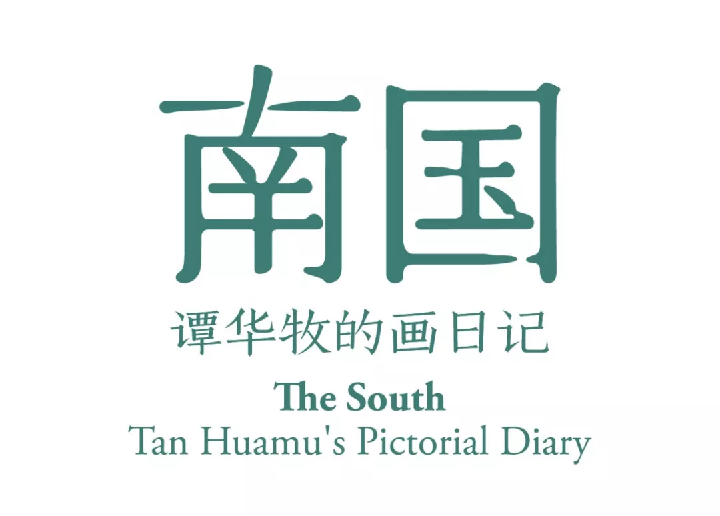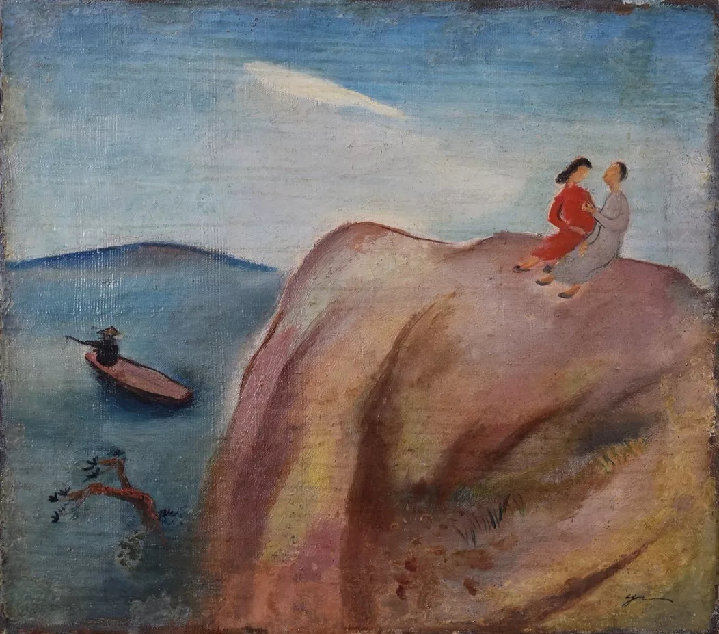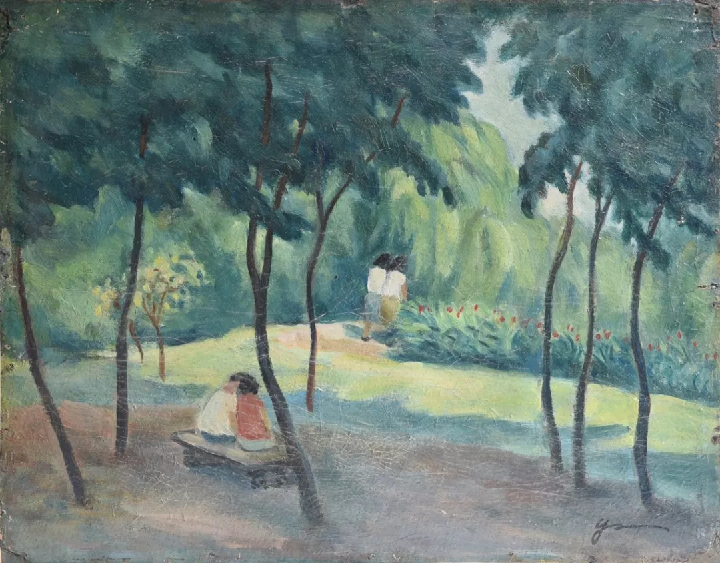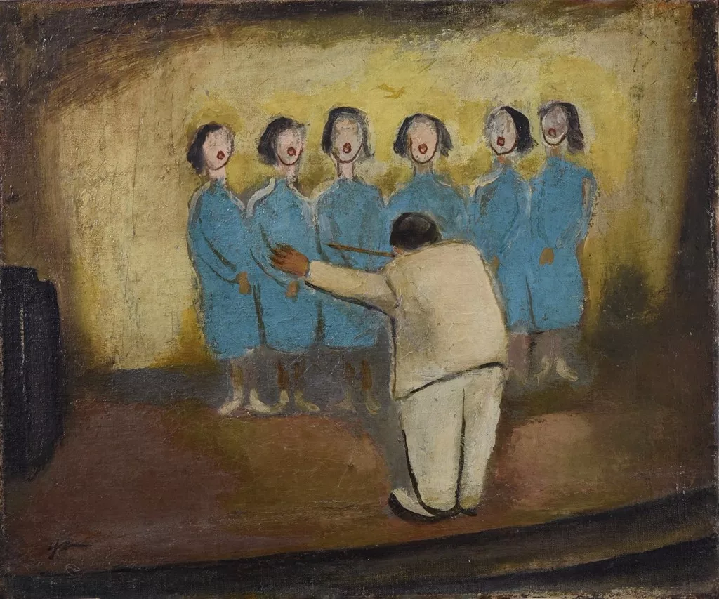Time
Until June 17, closed Mondays
Tickets
A missing person in art history| Until June 17
Venue
Metro
Line 1 to OCT Station (华侨城站), Exit C
Until June 17, closed Mondays
A missing person in art history| Until June 17
Line 1 to OCT Station (华侨城站), Exit C

Back in September last year, among the hundreds of paintings by renowned Guangdong masters at the Guangdong Art Centennial Exhibition in Shenzhen, oil painting “Chorus” was not the most eye-catching piece on display since it was small in size, without splendid landscapes, elegant flowers nor striking portraits. Even if visitors had a glance at the painter’s name in the caption, the name “Tan Huamu” would soon be forgotten afterwards as visitors moved on to admire paintings by other big names. To many, Tan’s significance was unknown.

Oil painting “Scenery” by Tan Huamu.
This summer, He Xiangning Art Museum is organizing a retrospective of Tan’s works, the first ever in Shenzhen. On display are all his significant pieces, including “Chorus,” “Landscape” and “Zhenhai Tower.” Some oil paintings appear together with scores of preparatory sketches.
“This exhibition traces the exceptional career of Tan Huamu through his ‘pictorial diary’,” said Cai Tao, curator of the exhibition, which is titled “The South: Tan Huamu’s Pictorial Diary.”
Born in 1896 in Taishan, Guangdong, Tan was admitted to the Tokyo Fine Arts School to study Western painting in 1919. After he returned to China in 1924, he became a pioneer in modern Chinese art education, teaching in several schools in Guangzhou and Shanghai. As early as in the 1920s, he was regarded as a representative of Chinese modern art, which combines Post-Impressionism, Fauvism and Chinese literati painting.
During the War of Resistance Against Japanese Aggression, Tan moved to Macao. In 1956, he returned to Guangzhou to reunite with his family and thereafter worked as a painter at Guangdong Academy of Painting until his death in 1976. As an introverted and low-profile figure, Tan rarely exhibited his works and was considered “a missing person in art history.”

Oil painting “Lean on” by Tan Huamu.
Most of Tan’s paintings are in green and blue tones with subjects like trees, the sky and fields, sending off the pleasant and heart-soothing feelings of South China. He usually went fishing and made sketches at Guangzhou’s Yuexiu Park, Guangzhou Martyr Cemetery, Xicun Village and Fangcun Village. Tan was in favor of painting farmers laboring in fields, lovers and students relaxing in parks, and children playing in street lanes. Students’ red scarves in his paintings form a beautiful echo with the red kapok flowers.
“Tan’s paintings express the dynamic interaction between nature, humans and society. We can make a comparison between him and English artist L.S. Lowry, ” said Cai.

Oil painting “Chorus” by Tan Huamu.
In “Chorus,” Tan only painted six young female singers’ opening red mouths with omission of eyes and noses. The simple and vivid strokes in this painting are like a light-hearted song. Cai noted that although Tan’s paintings look simple and small, the artist was very smart in composition and handling details.
画家谭华牧出生于著名侨乡——广东台山,是中国现代美术史上一位“失踪”的先驱者,至今极少有人了解和看过他的作品。
1956年,画家谭华牧从澳门回到广州定居,他的最后二十年在这个南方城市度过。归国后他日复一日地面对身边的景致进行写生和构思,绘制了大量画稿,其中很少一部分发展成了油画作品。在不少画稿的背面,标有详细日期——本次画展将以这些“画日记”为线索,回顾这位现代艺术家的卓越画业。
谭华牧生于1896年,1919年进入东京美术学校学习西洋画,1924年归国后,在广州、上海等地多所美术学院任职,引领一时之风气。抗战期间,谭氏移居澳门,战后回到广州,出任广东省立艺术专科学校教授兼总务主任。1940年代末期,谭氏重返澳门,1956年再次回到广州,与家人团聚,此后担任广东画院画家,直至1976年去世。
谭华牧是20世纪最早尝试中西画风融合的现代艺术家之一,1920年代他就被视为新派洋画的代表人物:这种糅合了后印象派、野兽派以及文人画意的新风尚,代表了早期中国现代艺术的成熟发展。但性格内向的谭华牧极少对外公布作品,因此被 视为“现代美术史上的失踪者”。
本次展览除了展示谭氏归国前后的代表作之外,大部分作品和珍贵文献都是首次与观众见面。展览深入介绍了这位现代隐士的独特的跨媒介工作方式,同时,还揭示了一个久被遗忘的美术史现象——由谭华牧、关良、丁衍庸等留日艺术家,共同发展出的中国现代绘画的创新之路。
Dates: Until June 17, closed Mondays
Venue: He Xiangning Art Museum, Overseas Chinese Town, 9013 Shennan Boulevard, Nanshan District (南山区深南大道9013号华侨城何香凝美术馆)
Metro: Line 1 to OCT Station (华侨城站), Exit C